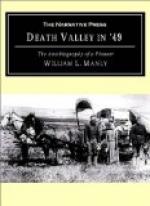We passed the Mission about noon or a little after, and a few miles beyond met a man on horseback who lived up to the north about a hundred miles. His name was French and he had a cattle range at a place called Tejon (Tahone). Our friends told him who we were, and what assistance we needed. Mr. French said he was well acquainted in Los Angeles and had been there some time, and that all the travelers who would take the Coast route had gone, those who had come by way of Salt Lake had got in from two to four weeks before, and a small train which had come the Santa Fe Route was still upon the road. He said Los Angeles was so clear of emigrants that he did not think we could get any help there at the present time.
“Now,” said Mr. French—“You boys can’t talk Spanish and it is not very likely you will be able to get any help. Now I say, you boys turn back and go with me and I will give you the best I have, I will let you have a yoke of gentle oxen, or more if you need them, and plenty of beans, which are good food for I live on them; besides this I can give an Indian guide to help you back. Will that do?” After a moment we said we doubted if oxen could be got over the road, and if they were fat now they would soon get poor, and perhaps not stand it as well as the oxen which had became used to that kind of life, and of those they had in camp all they needed. We wanted to get something for the women and children to ride, for we knew they must abandon the wagons, and could not walk so far over that dry, rough country. “Well,” said Mr. French:—“I will stop at the place you were this morning—I know them well—and they are good folks, and I am sure when I tell them what you want they will help you if they possibly can. This looks to me to be the most sensible course.” After talking an hour our two companions advised us that the proposition of Mr. French seemed the most reasonable one that appeared. But for us to go clear back to his range would take up so much valuable time that we were almost afraid of the delay which might mean the destruction of our friends. French said he had a pack saddle, with him taking it home, and we could put it on one of our horses, and when we came back to Los Angeles could leave it at a certain saloon or place he named and tell them it belonged to him and to keep it for him. I have forgotten the name of the man who kept the saloon. We agreed to this, and bidding our two companions farewell, we turned back again with Mr. French.
When night came we were again at the Mission we had passed on the way down. We were kindly treated here, for I believe Mr. French told them about us. They sent an Indian to take our horses, and we sat down beside the great house. There were many smaller houses, and quite a large piece of ground fenced in by an adobe wall. The roof of the buildings was like that of our own buildings in having eaves on both, sides, but the covering was of semi circular tiles made and burned like brick. Rows of these




